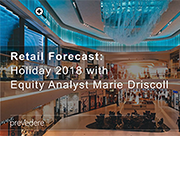Last Updated: September 9, 2018
All indicators point to year-over-year growth for the 2018 holiday retail season, making this year the tenth consecutive (paywall) year of growth for holiday spending.
The overall economy has been steadily growing; the U.S. has experienced 17 consecutive quarters (paywall) of GDP growth, a recent Reuters article reports that the economy is generally considered to be strong and consumers have been spending. Additionally, the Organization for Economic Co-Operation and Development reports that consumer confidence is at a 10-year high.
 However, despite all signs pointing to a positive 2018 holiday retail season, some retailers may not feel it. This is because, while we can expect growth, eMarker predicts that it will likely be slower than the growth retailers have experienced during the last four years. Read the latest Prevedere 2018 holiday retail season outlook with expert Equity Analyst & CEO, Marie Driscoll.
However, despite all signs pointing to a positive 2018 holiday retail season, some retailers may not feel it. This is because, while we can expect growth, eMarker predicts that it will likely be slower than the growth retailers have experienced during the last four years. Read the latest Prevedere 2018 holiday retail season outlook with expert Equity Analyst & CEO, Marie Driscoll.
2018 Holiday Retail Season Analysis
Since the 2014 holiday season, retail has experienced between 2% and 6% growth year-over-year. And while there has been much discussion about traditional retailers losing too much spend to new e-tailers, I haven’t seen this come to fruition, in part because spending growth seems to have outperformed the supply offered by emerging e-commerce companies and, therefore, there was enough demand for retailers to have a positive 2018 holiday season (paywall).

Simply put, although the U.S. Census Bureau reports that e-commerce spending has grown quickly, the larger pie of consumer spending appears to have kept pace to support growth for all retailers.
In 2018, while there will still be growth, it will likely not be at the same level as the trend over the last four years for all retailers. As such, CNBC reported a deceleration in consumer spending this year, which means that consumer spending is growing, but at a slower rate.
The Bureau of Labor Statistics reports that employment is currently close to full-employment, meaning that there won’t be a significant number of consumers whose spending power would increase due to new employment. At the same time, personal savings is at an all-time low (paywall) meaning that consumers will be more reliant on their wages during the 2018 holiday season and won’t have extra money in their “piggy banks” to pull from.
While the Wall Street Journal suggests wages may be showing signs of growth, Bloomberg recently reported that they are being outpaced by inflation and cannot be relied upon for a boon. In the past, the growth of consumer confidence and sentiment has helped with increased spending. But considering these indicators are at a 10-year high, I don’t believe there is room for further growth. When consumer confidence is high over prolonged periods of time, there needs to be room for growth in other areas for consumer confidence to remain high; the same conditions won’t maintain the same level of confidence.
***
Post written by Andrew Duguay is a senior economist with Prevedere Software. This post first appeared in Forbes on August 24, 2018, appeared in Forbes I help Fortune 500 companies plan for tomorrow.
